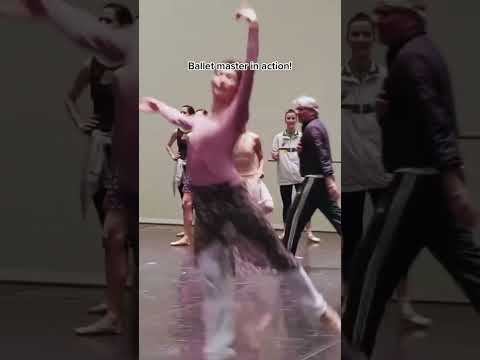Ballet Master Job Description and Salary: All You Need to Know!

Ballet Master Job Description Template
Ballet Master Job Description A ballet master is a highly skilled individual who plays a crucial role in the world of ballet. They are responsible for overseeing the training and development of dancers, as well as ensuring the quality and artistic integrity of ballet performances. One of the most important roles of a ballet master is to create and implement training programs for dancers. They work closely with the artistic director to determine the artistic vision and goals of the ballet company, and then design training programs that align with these objectives. This involves selecting and choreographing ballet repertoire, teaching techniques, and coaching dancers to improve their skills and performance quality. Another important aspect of the ballet master’s job is to rehearse and stage ballet productions. They work closely with the choreographer and dancers to ensure that the movements and sequences are executed correctly and in line with the artistic vision. They also provide guidance and feedback to dancers, helping them refine their technique and interpretation of roles. In addition to their training and rehearsal responsibilities, ballet masters may also be involved in casting decisions, collaborating with costume and set designers, and mentoring young dancers. They are expected to have a deep knowledge and understanding of ballet history, repertoire, and technique. Overall, the role of a ballet master is essential in maintaining the high standards and artistic excellence of ballet performances. Their expertise and guidance are vital in shaping the artistic development of dancers and ensuring the success of ballet productions.Ballet Master Responsibilities
- Creating and planning ballet classes and rehearsals
- Teaching and demonstrating ballet techniques to dancers
- Choreographing and staging ballet productions
- Providing guidance and feedback to dancers to improve their skills
- Ensuring the safety and well-being of dancers during rehearsals and performances
- Collaborating with costume designers, set designers, and lighting designers to create a cohesive production
- Overseeing the artistic vision and integrity of the ballet company
- Working closely with the artistic director to select and cast dancers for productions
- Attending meetings and collaborating with other staff members to plan and coordinate performances
- Continuously researching and staying updated on current trends and developments in ballet
Ballet Master Requirements
How Much Does A Ballet Master Make?
Ballet Master Salary
| Country | Minimum Salary | Maximum Salary |
|---|---|---|
| United States | $45,000 | $150,000 |
| United Kingdom | £30,000 | £80,000 |
| Germany | €40,000 | €100,000 |
| Russia | ₽2,000,000 | ₽5,000,000 |
A ballet master, also known as a ballet director or ballet mistress, is a highly skilled and experienced professional in the field of ballet. They are responsible for overseeing and coordinating ballet productions, training and coaching dancers, and ensuring the artistic vision of the ballet company is realized.
The salary of a ballet master can vary depending on factors such as the country, the size and reputation of the ballet company, and the individual’s level of experience and expertise. In the United States, the minimum salary for a ballet master is around $45,000 per year, while the maximum can reach up to $150,000. In the United Kingdom, the minimum salary is approximately £30,000, with a maximum of around £80,000. In Germany, ballet masters can earn between €40,000 and €100,000 annually. In Russia, the salary range is much higher, with minimum salaries starting at ₽2,000,000 and maximum salaries reaching up to ₽5,000,000.
Overall, being a ballet master requires immense dedication, skill, and talent, and the salary reflects the importance and value of their role in the world of ballet.
Ballet Master Salaries by Country
Top Paying Countries for Ballet Master
| Country | Salary Range |
|---|---|
| United States | $60,000 – $150,000 |
| United Kingdom | £40,000 – £100,000 |
| Russia | ₽1,500,000 – ₽5,000,000 |
| France | €40,000 – €120,000 |
| Germany | €50,000 – €100,000 |
Ballet masters are highly skilled professionals who play a crucial role in the ballet industry. They are responsible for overseeing the training and development of dancers, as well as choreographing and directing performances. The salaries of ballet masters vary significantly depending on the country they work in. According to recent data, the top paying countries for ballet masters include the United States, United Kingdom, Russia, France, and Germany. These countries offer competitive salary ranges, often ranging from $60,000 to $150,000 in the United States, £40,000 to £100,000 in the United Kingdom, ₽1,500,000 to ₽5,000,000 in Russia, €40,000 to €120,000 in France, and €50,000 to €100,000 in Germany. These figures reflect the importance and demand for ballet masters in these countries, as they contribute significantly to the success and artistic excellence of ballet companies.
A video on the topic Ballet Master
Video Source : Free Movement™ SolutionsInterview Questions for Ballet Master
1. What is the role of a Ballet Master in a ballet company?
A Ballet Master is responsible for teaching and rehearsing ballet dancers, ensuring that they perform the choreography correctly and maintain the artistic integrity of the ballet production.
2. What qualifications and experience are required to become a Ballet Master?
To become a Ballet Master, one typically needs to have extensive training and experience as a professional ballet dancer. They should also possess strong teaching and coaching skills, as well as a deep understanding of ballet technique and repertoire.
3. How do you collaborate with the choreographer in creating a ballet production?
A Ballet Master works closely with the choreographer to bring their vision to life. They help in interpreting and teaching the choreography to the dancers, ensuring that the movements are executed correctly and in line with the choreographer’s intentions.
4. What strategies do you use to improve the technical skills of ballet dancers?
As a Ballet Master, I employ various strategies to enhance the technical skills of ballet dancers. These include providing individualized feedback, organizing specialized technique classes, and implementing targeted exercises to address specific areas of improvement.
5. How do you ensure that the dancers maintain their physical condition and prevent injuries?
I work closely with the dancers to create personalized conditioning and strengthening programs to help them maintain their physical fitness. Additionally, I emphasize proper warm-up and cooldown routines, and educate the dancers on injury prevention techniques.
6. How do you handle conflicts or disagreements among dancers during rehearsals?
In the event of conflicts or disagreements, I aim to create an open and respectful environment where dancers can express their concerns. I mediate discussions and work towards finding a resolution that benefits the overall artistic integrity of the ballet production.
7. How do you approach the training of aspiring professional ballet dancers?
I approach the training of aspiring professional ballet dancers with a focus on technical excellence, artistic expression, and versatility. I provide them with individual attention, constructive feedback, and guidance to help them develop their unique strengths and reach their full potential.
8. How do you stay updated with current trends and developments in the ballet industry?
I stay updated with current trends and developments in the ballet industry through attending workshops, masterclasses, and conferences. I also engage in continuous learning by studying new choreographic works and collaborating with other professionals in the field.
9. What is your approach to fostering a positive and supportive environment within the ballet company?
I believe in fostering a positive and supportive environment by encouraging open communication, mutual respect, and teamwork among the dancers. I also promote a culture of inclusivity and celebrate the individual achievements and contributions of each dancer.
10. How do you handle the pressure and demands of working in a highly competitive ballet company?
Working in a highly competitive ballet company can be demanding, but I manage the pressure by maintaining a structured and organized approach to rehearsals and performances. I prioritize the well-being of the dancers and emphasize the importance of balancing hard work with self-care.






